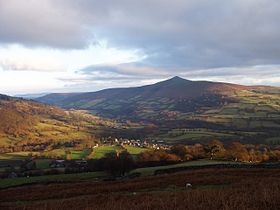- Sugar Loaf (Wales)
-
For other mountains called "Sugarloaf", see Sugarloaf (mountain).
Sugar Loaf
The Sugar Loaf from the north-west, with the village of Llanbedr in the valley belowElevation 596 m (1,955 ft) Prominence 413 m (1,355 ft) Parent peak Waun Fach Listing Marilyn Location Location Monmouthshire,  Wales
WalesRange Black Mountains Topo map OS Landranger 161 OS grid SO272187 Sugar Loaf, sometimes called The Sugar Loaf (Welsh: Mynydd Pen-y-Fal or Y Fâl), is a mountain situated 2 miles (3.2 km) north-west of Abergavenny in Monmouthshire, Wales. It is the most southern and lowest of the summit peaks [1] of the Black Mountains,[2] with a height of 1,955 feet (596 metres).
Contents
View from the Summit
The view from the summit[3] covers the Black Mountains to the north, the Cotswolds to the east, as far as the Brecon Beacons including Pen Y Fan and Corn Du to the west and the Bristol Channel to the south.
Prehistory
A mountain foothill, Y Graig, was discovered in the 1990s to be the site of prehistoric flint tools dating from the Mesolithic, Neolithic and Bronze Age.
Walking
The Sugar Loaf is very popular with walkers and hillwalking enthusiasts and offers easy ascents on foot from the Sugar Loaf car park at about 1000 feet (halfway) or longer ascents from Abergavenny and Crickhowell or Llangenny.[4]
Geology
It is a popular misconception that Sugar Loaf is an 'extinct volcano'; an idea born perhaps from the striking resemblance of its conical outline, particularly when seen from the east, to that of a classic volcano. It is however composed entirely of sedimentary rocks. In common with the rest of the Black Mountains, the hill is formed from Old Red Sandstone which was laid down during the early Devonian period. Its lower slopes (up to around 1000 ft / 300m) are composed of mudstones and sandstones assigned to the Senni Beds Formation whilst its upper reaches are composed of the more sandstone-rich sequence known as the Brownstones Formation. The very summit of Sugar Loaf is formed from sandstones of the Quartz Conglomerate Group which are of late Devonian age. There are a number of landslips on its flanks which are believed to date from early post-glacial times. The former Usk Valley glacier divided to north and south of it as it travelled eastwards, though the mountain itself is largely free from glacial till.[5]
Land use
The mountain is in the ownership of the National Trust who manage its grazing by Welsh mountain sheep. The lower slopes are deciduous mixed woodland with fern, heather and Bilberry, known locally as whinberry, on the upland slopes. The wooded slopes have been designated a Site of Special Scientific Interest.
A vineyard, producing Sugar Loaf British wines, is situated at Dummar Farm at the foot of the mountain on south facing slopes near Abergavenny.
External links
References
- ^ Geograph photo
- ^ Geograph photo
- ^ Geograph photo
- ^ Geograph photo
- ^ British Geological Survey 50K map sheet 232, Abergavenny, & accompanying memoir.
Categories:- Black Mountains, Wales
- Geography of Monmouthshire
- Mountains and hills of south Wales
- Sites of Special Scientific Interest in Gwent
- Landmarks in Wales
- Marilyns of Wales
Wikimedia Foundation. 2010.

